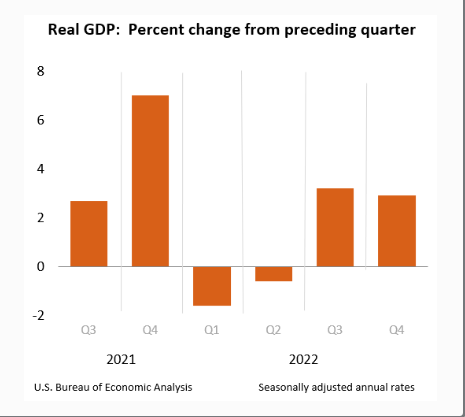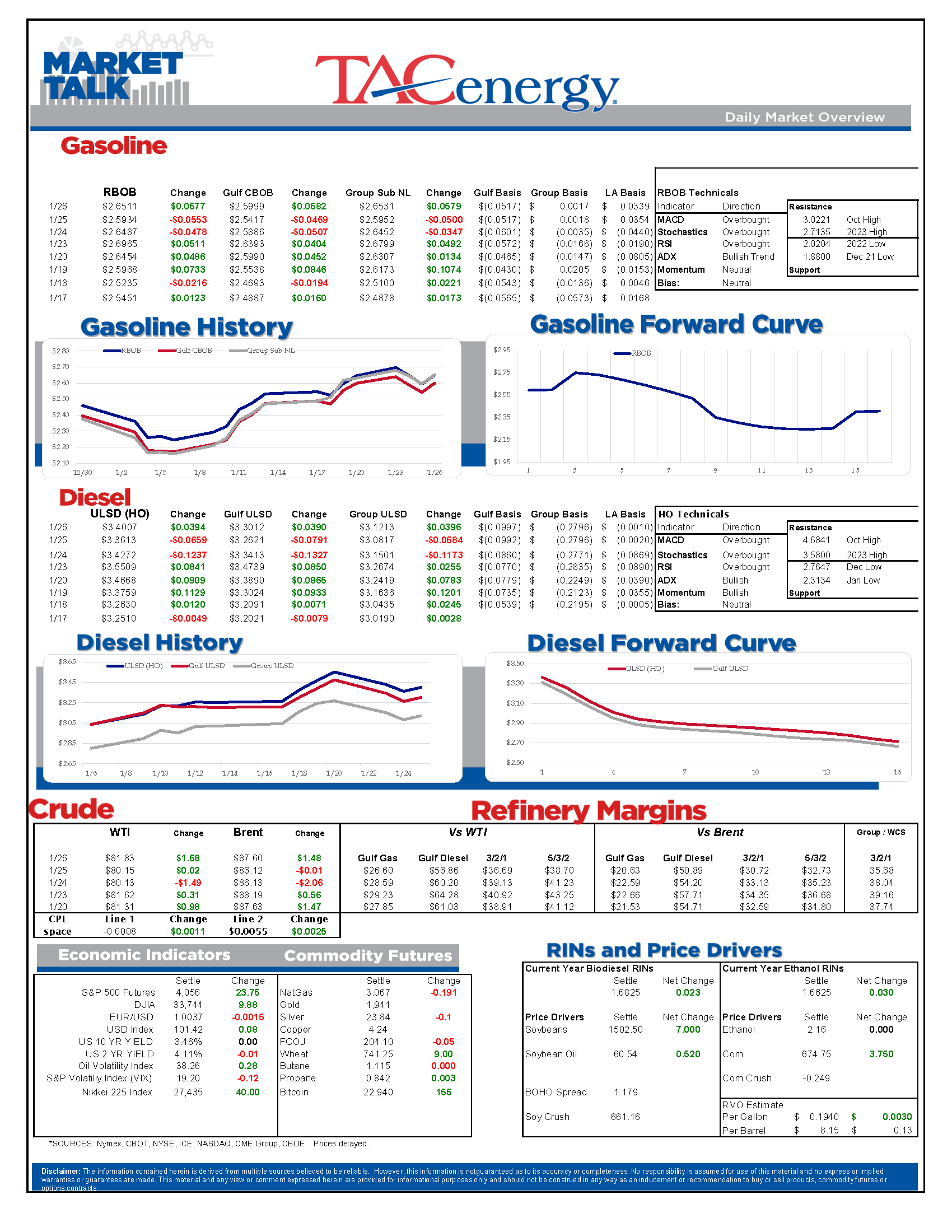Refined Products Bounce Keeping Prices Well Above Their 6-Week-Old Trend Lines

Refined products are bouncing back this morning after 2 days of selling as a bit of economic optimism appears to be creeping back into the market. The bounce keeps prices well above their 6-week-old trend lines and keeps the bulls in position to push prices substantially higher in the coming weeks and makes the past two days of selling look like nothing more than profit taking to cure an overbought market.
Stocks and energy prices reacted positively to the 4th quarter US GDP estimates this morning that showed the economy continued to expand, albeit at a slower pace than in Q3, and that the consumer continues to be resilient with purchases and savings despite so much consternation about a looming recession. International travel was noted as a highlight in this report, and could be a major theme this year as China has reopened its doors while many other countries get closer to business as usual and release the pent up demand of 3 years of COVID travel restrictions.
Despite surging exports, light imports, and no more SPR releases, crude oil inventories continue to build in the US as refinery runs continue to be far below planned levels. The recovery from the Christmas blizzard and a handful of other events in the past few weeks continues, but we’re still seeing utilization that’s several percentage points below where it would be otherwise. These lower run rates on top of already low inventory levels would be much more painful if demand wasn’t still very sluggish, and adding another anecdote for the half that think the US economy is already in a recession.
Then again, it’s also January which is typically the worst demand month of the year, and we’re in the midst of a parade of winter storms sweeping the entire country and keeping many vehicles off the road, so if we do see a normal demand rebound heading into the spring months, supply may get very tight again in short order.
Valero reported another banner quarter in Q4 this morning, and ended the year with net income of $11.8 billion, compared to $1.3 billion in 2021. The company’s refineries operated at 97% during the quarter, which was the highest since 2018 as they, along with all the others that were able, maximized output to try and help alleviate chronic inventory shortages and take advantage of the record margins those shortages bring. The report also noted that the expansion of their newest Diamond Green renewable diesel facility was completed during the quarter, and the coker project at the Port Arthur refinery which will expand capacity is due to be completed in Q2.
Total reported Wednesday that its refinery outside Houston was knocked offline during Tuesday’s severe weather event. The report suggests the plants boilers were restarted early Wednesday morning, suggesting that the facility avoided any major damage. That facility is just a couple of miles from the Deer Park refinery that was also knocked offline during the storm and restarted a few hours later. Those are the only two facilities reporting so far, while several others in the region have said their operations remain stable, so it seems we’ve avoided a major disruption from that system.
News & Views
View All
Crude Oil, Gasoline, And Diesel Benchmarks Are All Trading >1% Lower To Start The Day
Energy prices are sinking again this morning, albeit with a little more conviction than yesterday’s lackadaisical wilting. Crude oil, gasoline, and diesel benchmarks are all trading >1% lower to start the day with headlines pointing to an across-the-board build in national inventories as the source for this morning’s bearish sentiment. The Department of Energy’s official report is due out at its regular time this morning (9:30am CDT).
WTI has broken below its 100-day moving average this morning as it fleshed out the downward trend that began early last month. While crossing this technical threshold may not be significant in and of itself (it happened multiple times back in February), the fact that it coincides with the weekly and monthly charts also breaking below a handful of their respective moving averages paints a pretty bearish picture in the short term. The door is open for prices to drop down to $75 per barrel in the next couple weeks.
Shortly after the EIA’s weekly data showed U.S. commercial crude inventories surpassing 2023 levels for the first time this year, their monthly short-term energy outlook is forecasting a fall back to the bottom end of the 5-year range by August due to increasing refinery runs over the period. However, afterward the administration expects a rise in inventories into 2025, citing continued production increases and loosening global markets hindering the incentive to send those excess barrels overseas. The agency also cut back their average gas and diesel price forecasts for the first time since February with the biggest reductions in the second and third quarter of this year.
The STEO also featured their famed price prediction for WTI, stating with 95% confidence that the price for crude oil will be between $40 and $140 through 2026.
Need a general indication of the global crude oil supply? Most headlines seem to be covering a shortage of a different type of oil, one that we haven’t turned into fuel (yet).
Click here to download a PDF of today's TACenergy Market Talk.

The Perceived Cooling Of Regional Tensions In The Middle East Area Attributing To The Quiet Start To Today’s Trading Session
The energy complex is drifting lower this morning with RBOB futures outpacing its counterparts, trading -.9% lower so far to start the day. The oils (WTI, Brent, heating) are down only .2%-.3% so far this morning.
The perceived cooling of regional tensions in the Middle East area attributing to the quiet start to today’s trading session, despite Israel’s seizure of an important border crossing. A ceasefire/hostage-release agreement was proposed Monday, and accepted by Hamas, but rejected by Israel as they seemingly pushed ahead with their Rafah offensive.
U.S. oil and natural gas production both hit record highs in 2023 and continue to rise in 2024, with oil output currently standing at 13.12 million barrels per day and January 2024 natural gas production slightly exceeding the previous year. With WTI currently changing hands at higher than year-ago levels, this increased production trend is expected to continue despite a decrease in rigs drilling for these resources.
Less than a week after the Senate Budget Committee’s hearing centered on the credibility of big oil’s climate preservation efforts, a major oil company was reported to have sold millions of carbon capture credits, without capturing any carbon. Fraud surrounding government subsidies to push climate-conscious fuel initiatives is nothing new, on a small scale, but it will be interesting to see how much (if any) of the book is thrown at a major refiner.
Today’s interesting read: sourcing hydrogen for refining.
Click here to download a PDF of today's TACenergy Market Talk.

Energy Contracts Are Trying To Find A Floor After Taking Their Largest Weekly Losses Of The Year So Far Last Week
Energy contracts are trying to find a floor after taking their largest weekly losses of the year so far last week.
There’s not much in the way of news yet this morning, so the modest buying is largely being blamed on reports that Saudi Arabia raised its prices for Asian and Mediterranean buyers in June, signaling that demand is strong enough in those markets to shoulder the increase.
RBOB gasoline futures have already dropped 28 cents from the high set April 12th, leading the argument that prices have peaked for the season. The 200-day moving average comes in just under $2.50/gallon this week, some 6.5 cents below current values, and helps set a pivotal chart support layer. If prices break there, there’s a strong case that we’ll see another 20-30 cents of downside, similar to what we saw this time last year.
Money managers continued to reduce their net length in NYMEX contracts last week, as WTI, RBOB and ULSD saw a net decrease of more than 17,000 contracts of speculative length. The hedge fund liquidation seems to have run its course for this latest news cycle however, as new short positions accounted for the majority of the decrease, and WTI and Brent both saw new length added by the big speculators. Money managers are now net-short on ULSD, which could be another reason to think the bottom is near if you subscribe to the theory that the bandwagon-jumping hedge funds usually are wrong.
Baker Hughes reported a decline of 7 oil rigs and 3 natural gas rigs last week, bringing the combined total rig count to its lowest level in more than 2 years. Perhaps most noteworthy in this week’s report was that Alaska saw 5 of its 14 active rigs taken offline in just 1 week. It’s not yet clear if this may have anything to do with the startup of the transmountain pipeline which will have Western Canadian crude now competing more directly with Alaskan grades.
Click here to download a PDF of today's TACenergy Market Talk.

